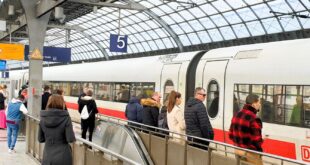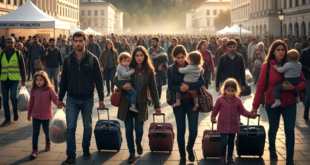A new kind of reception centres for refugees, where their asylum applications will be accelerated, has taken off in Germany. Seven migrant transfer centres have begun operation in Bavaria. Interior Minister Horst Seehofer hopes to use them to bundle and accelerate asylum procedures, but critics say they will create more problems, not fewer. Esther Felden reports.
Speeding up asylum proceedings and bringing them all under one roof — simply put, that’s the idea behind Germany’s migrant transfer centres, also known as “Anker” centres (Anker stands for “Centre for Arrival, Decision and Return”).
Up to 1,500 refugees and migrants can be housed in each centre. Arrivals, asylum applications and the decisions on those applications — everything is to take place at the centres, including deportations.
In each of the seven locations in Bavaria, which officially began operations as “Anker centres” on August 1, every agency involved in the asylum process will be present on site, the state interior minister for Bavaria, Joachim Herrmann, recently told reporters.
The pilot phase for the centres will last around six months, after which initial evaluations are planned. Only after these evaluations are complete will the German federal government have to create a legal basis for the centres — and it would be dependent on the country’s 16 states to do so.
However, approval for the plans is limited. Apart from the eastern state of Saxony, which is to set up a centre of its own in Dresden, only Hesse and North Rhine-Westphalia have expressed interest so far.
Up to 18 months in a shelter
One of the goals of the centres is to accelerate decisions on asylum applications. Werner Schiffauer, chairman of the Council for Migration, told DW he doubts this will actually work in practice.

Although it would make sense to bring together all the local authorities involved in the overall asylum process to ensure better cooperation, Schiffauer doesn’t believe that everything will now be faster.
“In clear cases, especially with Syrians who come directly from war zones, the procedures will certainly be accelerated. But what will hardly change are the difficult cases, for example refugees from Afghanistan who have fled for the second time,” he said.
Schiffauer noted that in two migrant reception centres in Bamberg and Manching, the process hasn’t been accelerated. Well over 1,000 people are being accommodated in each of the two Bavarian centres. The people there live in close quarters without anything to do and are largely isolated from the outside world. It’s precisely these conditions that have been criticized by refugee organizations.
“Ten percent of the inhabitants in Manching have been there for more than 18 months,” the Bavarian Refugee Council said in a statement. They added that people in these large camps suffer from “bans on working, compulsory stays, having cash taken away from them, a lack of German language courses and insufficient schooling.”
According to German Interior Minister Horst Seehofer, no one would be allowed to stay in one of the new migrant transfer centres for longer than 1 1/2 years.
Werner Schiffauer, chairman of the Council for Migration, doesn’t think the new centres will speed up asylum processes
Approach ‘counterproductive’ to integration
It’s not just aid organizations that have lamented the amount of time asylum-applicants will have to spend in the centres; the Berlin Senate’s Department for Integration, Labour and Social Affairs has criticized the entire concept.
Spokeswoman Regina Kreiding told DW that they will adhere to the legal situation, “but politically, we consider it counterproductive and not conducive to integration when so many people are held in such large shelters over such a long period of time.”
Schiffauer, who is also a migration researcher, believes one of the main goals of the centres is to keep refugees from coming to Germany.
“Anker centres act as a deterrent, that’s clear. It’s about sending a signal to refugees that they are not entirely welcome here,” he said.
This tactic might work, but it comes at the expense of integration. The more difficult conditions in a migrant transfer centre — such as the controversial stipulation that requires them to reside in the centre — could also be traumatic for the refugees.
Concerns about prison-like conditions
Schiffauer also warned about the consequences for the entire region in which the centres are located. He believes problems will be inevitable since the centres would be perceived as prisons by both the people living in them and the communities that surround them.
“It is a burden for a city to have an Anker centre,” the chairman of the Council for Migration said, noting that the placement of such centres can “poison the social climate and also create counter initiatives.”
Overall, Schiffauer believes that politicians are trying to send a political signal to voters by creating the centres.
“It sends a signal to the majority in society: ‘We are doing something; we’re going to get the whole thing under control,'” he said.
However, Schiffauer believes this message is a fallacy since these types of policies push people towards illegal options. He noted that in Switzerland, where similar centres already exist, many people flee before they are supposed to be deported, going on to live illegally in neighbouring countries.
“Order is promised here, but in fact, more disorder is created,” he said.
According to Bavaria’s Refugee Council, around 30 percent of the people slated for deportation in Manching and Bamberg disappeared before their departure date.
© DW
 THE AFRICAN COURIER. Reporting Africa and its Diaspora! The African Courier is an international magazine published in Germany to report on Africa and the Diaspora African experience. The first issue of the bimonthly magazine appeared on the newsstands on 15 February 1998. The African Courier is a communication forum for European-African political, economic and cultural exchanges, and a voice for Africa in Europe.
THE AFRICAN COURIER. Reporting Africa and its Diaspora! The African Courier is an international magazine published in Germany to report on Africa and the Diaspora African experience. The first issue of the bimonthly magazine appeared on the newsstands on 15 February 1998. The African Courier is a communication forum for European-African political, economic and cultural exchanges, and a voice for Africa in Europe.


































